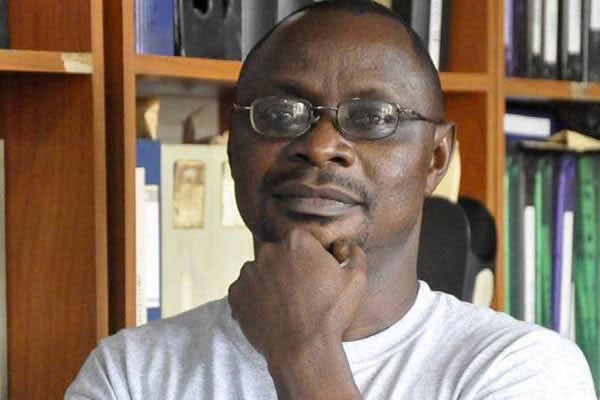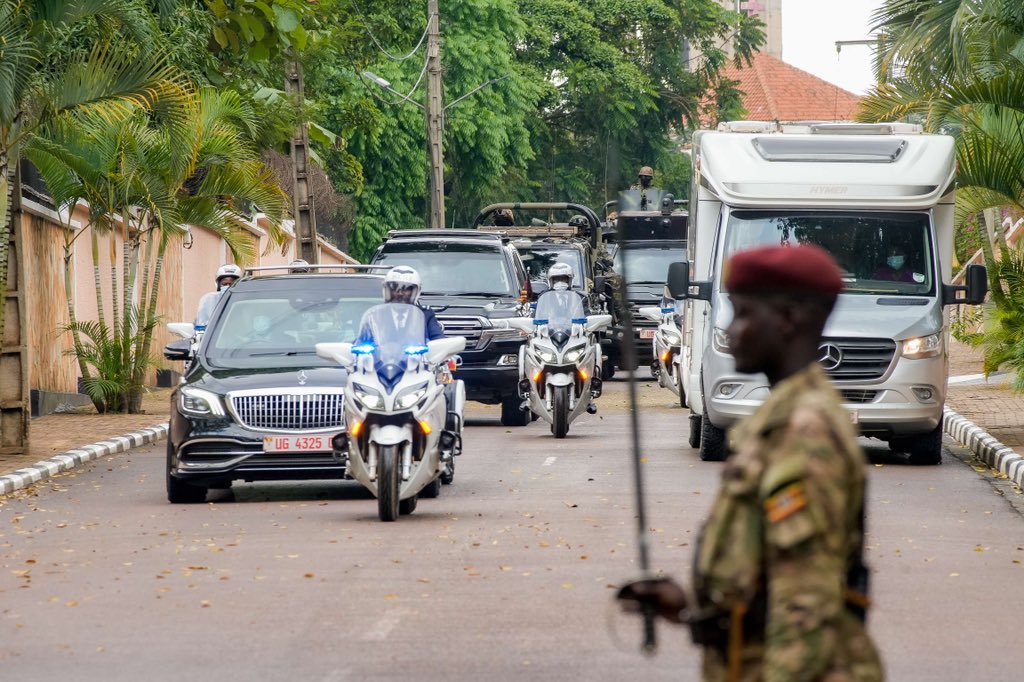Prime
In a sorry state: SONA 2023

President Museveni waves as he arrives at Kololo ceremonial grounds in Kampala to deliver his state of the nation address on June 7, 2023. PHOTO/ DAVID LUBOWA
What you need to know:
- Although income per capita increased from $936 in FY2020/2021 to $1,052 in FY2021/22, what $1,000 a year means was not discussed.
There was plenty that was predictable in the State-of-the-Nation Address (SONA) for 2023/24. Chiefly, a performance review claiming economic recovery from Covid resulting from government interventions. In the year ended December 2022, 60 percent of households increased their incomes. Emyooga and the Parish Development Model (PDM) are said to be building on this and already directly to benefit 1.9 million people.
There was the coffee, either 5.7 million 50kg bags or 9 million 60kg bags (both figures are used), milk production leapt a staggering 193 percent. Tourism accounted for $1.047b of the $1.776b service export earnings. Total exports earned $6.0484b for the calendar year ending 2022. No figures were given for remittances that earned more foreign currency than tourism pre-Covid.
The theme for Uganda’s budget for 2023/24 is “Full Monetisation of Uganda’s Economy through Commercial Agriculture, Industrialisation, Expanding and Broadening Services, Digital Transformation and Market Access”. The goals are to bring the 39 percent of households in the subsistence economy into the money economy, and to sustain Uganda’s socio-economic transformation agenda.
While pre-Covid the strategy was to promote economic recovery through cheap, easily accessible credit under Uganda Development Bank, Uganda Development Cooperation, Small Business Recovery Fund and the Agriculture Credit Facility, the focus is now on Emyooga and PDM through which households can access capital for seeds, breeding material, post-harvest handling, storage and processing. The parish is the centre for delivery of production, marketing and financial services to farmers.
What is interesting is what was not mentioned. Let’s begin by learning from the past. The size of the economy doubled from Shs64t in 2010/11 to Shs128t in 2018/19. But poverty rose from 19 percent in 2018 to 21 percent. Lesson number one, governance focuses on people and their quality of life, not on the size of the economy. Lesson two, Emyooga and PDM is just the latest in a long list of poverty alleviation schemes launched by this government. All have failed at the planning stage; Operation Wealth Creation, Naads, Bonna Bagaggawale, Entandikwa, Poverty Alleviation Programme, Youth Livelihood Project, Modernisation of Agriculture, and the Uganda Women Entrepreneurship Programme.
President Museveni makes an oblique reference to the Emyooga’s already evident shortcomings by stating efficiency improvements will be made wherever they are observed. He promised personally to visit districts where PDM funds have already been embezzled by the public servants meant to implement it.
The National Bureau of Standards warned the funds for the necessary data collection were diverted. Parish leaders have said in interviews that they are nowhere near ready, lacking even stationery. It is hard to see how a scheme launched without the required baseline data can succeed. It is likely to go the way of Uganda Airlines, Soroti Juice Factory and other food factories, Kiira EV and other enterprises launched without feasibility studies despite warnings from the Auditor General.
Incomes and poverty
Although income per capita increased from $936 in FY2020/2021 to $1,052 in FY2021/22 (exceeding the NDPIII target), what $1,000 a year means was not discussed. Undernourishment (caloric intake below minimum energy requirements) has been rising steadily since 2004 when it affected 23.8 percent of the population to 41 percent in 2019. At that point, government stopped supplying the data.
However, the trend of one to two percent a year indicates 44 to 47 percent of the population could be undernourished. It is understandable as only 37 percent of Ugandans get three meals a day. About 11 percent have one meal (22.4 percent in Acholi). Stunting rose by 1.3 percent between 2018 and 2020 (23.9 to 25.4). During that time household incomes were said to be rising.
Electrification
Having been told Uganda had an excess of hydroelectricity, and that Karuma Dam would supply it. In November 2020 it was discovered inappropriate cables had been attached to evacuate the power. That, financial shortages and construction defects delayed the operationalisation of the dam. At last this was acknowledged in SONA 2023 when Museveni said, “The construction of the transmission lines to evacuate this power, must be completed without further delays.” There is a similar promise not backed by anything when he promised “rural electrification will be completed by covering the remaining districts and sub-counties all over the country”.
Agriculture
The budgets of 2017, 2018 and 2019 promised post-harvest technologies when each county was to receive seed-oil extracting and grinder machinery; refrigeration, storage and transport. Irrigation has been promised since 2010. The anthem continues for FY2023/24 only this time the apparatus will materialise under the auspices of the PDM.
Health
Nothing at all was said about the collapse of the public health service. Just days earlier, a number of regional referral hospitals were disconnected from the national water supply for lack of payment. Billions are owed. In any case, only about 62 percent of health centres are even connected to national water grid.
The drug stock-out that began in late 2022 spread to health facilities across the nation, Senior Health Officers’ (SHOs) are on strike over pay and conditions of work, supervising specialists came out in sympathy with the SHOs. Government has failed to deploy 2,000 medical interns on the ground of a lack of funds. On June 7 when SONA 2023 was read, the Ministry of Health invited medical interns who are able to afford it, to volunteer to be signed up at their own expense.
Yet SONA focused on government’s modest, aid-assisted, achievements; upgrading 255 Health Centre IIs (dispensaries) to Health Centre III level (facilities with admission capability). The upgrades are financed by the Uganda Intergovernmental Fiscal Transfer (UgIFT) loan for human development of $798m (increased during the pandemic). There are approximately 6,698 health centres and clinics nationally.
They cater for 75 percent of the total disease burden. About 3,364 are HCIIs all of which are supposed to be phased out by upgrading to HCIII. Upgrading them by 255 a year will take 13 years. No mention was made in SONA23 of the 400 health professionals that were supposed to be recruited to serve in upgraded facilities.
A key strategy for the sector is to transform the health service from a predominantly curative to preventive service. That would need a higher doctor/patient ratio than exists, yet Museveni was and is silent on the deployment of medical interns who carry out over 70 percent of the work.
Overall health facilities are understaffed by 39 percent.
Education
As in 2021/22, government does not propose to build primary schools in 2023/24. Next year’s budget focuses on building systems digitally to track performance and completion rates. The very poor primary school completion rate of 60 percent or less didn’t come up in SONA23.
According to the World Bank’s completion report for Universal Primary Education, the problem is caused by the system itself; classroom crowding and the lack of desks and books as contributory factors. As a result, Uganda’s Minimum Years of Schooling dropped from seven years to six after 2019. Furthermore, academic achievement in those seven years is equivalent to four years (Human Development Index).
The two-unit laboratories supposed to have been built in 21 secondary schools were not mentioned in the achievements of the previous year. However, the famous 115 seed secondary schools constructed or under construction were. Like health centres, these are financed by UgIFT.
Like HCs, a number were abandoned by contractors. To meet government’s target of one secondary school per sub-county, we shall have to do a lot better than 115 schools every two or more years.
Affordability of government
Most of the barriers to human and economic development noted above are related to a shortage of funds. Why funds are persistently so short has been investigated and corruption as well as extravagance have been identified as major causes.
In 2020/21, prompted by NUP’s campaigning on this point, Gen Caleb Akandwanaho, aka Salim Saleh, identified Shs5t in potential savings from reducing government expenditure (NUP identified Shs3t). Where were these savings made? Where were they reallocated in the budget? The rationalisation of ministries, departments and agencies first touted in 2020 has been postponed yet again.
Yet State funerals have had an increase of Shs31.6b to a total of shs250b. The Shs31b increase in the State funerals budget could either build from scratch 16 secondary schools or upgrade 79 health centre IIIs to health centre IV level. In 2021, the modest plan was to rehabilitate (not build) 74 primary and 13 traditional secondary schools.
Ad-libbing while reading his address, Museveni said 245,890 of the tourists that visited tourist sites in the past year have been domestic (i.e. 67 percent of 367,000). This, he continued delightedly, is an indicator that poverty has been alleviated. “Mukulike obwaavu” (congratulations on coming out of poverty). The main thing missing from SONA 2023 is empathy with the poor.




